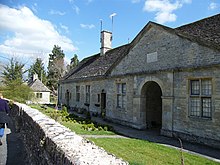 Cotswold Cottage, Coln St. Aldwyns | |
| Location | England, United States |
|---|---|
| Influences | Classical architecture, Tudor Revival |
The Cotswold style of architecture is a style based on houses from the Cotswold region of England. Cotswold houses often have a prominent chimney, often near the front door of the house.[1] Other notable features include king mullions and steep roofs. The Cotswold style uses local materials based on geology. This style is renowned for the use of local oolitic limestone. [2]
The Cotswold style emerged during the late 16th century and flourished throughout the 17th century.[3]: 6 During the second and third decades of the twentieth century, the Cotswold style reached its zenith of popularity. The Cotswold 'Arts and Crafts' architecture was a very popular and prominent style between 1890 and 1930.[4] The county of Gloucestershire in the Cotswolds became the focal point of the 'Arts and Crafts' architecture. [5]
Cotswold architecture is a subtype of the Tudor Revival house style, and it likely came to the United States as a result of renewed interest in medieval housing styles.
- ^ Marsland, Ellis (March 1906). "The Architecture of the Cotsmolds in the 16th & 17th Centuries". Architect's Magazine. 6: 88 – via ProQuest.
- ^ "Traditional Cotswold Materials and Contemporary House Design". HollandGreen. Retrieved 4 December 2023.
- ^ Dawber, Edward Guy (1905). Old Cottages, Farm-houses, and Other Stone Buildings in the Cotswold District: Examples of Minor Domestic Architecture in Gloucestershire, Oxfordshire, Northants, Worcestershire, &c. B. T. Batsford.
- ^ "The History Press | Cotswold Arts and Crafts architecture". www.thehistorypress.co.uk. Retrieved 4 December 2023.
- ^ "The Arts and Crafts Movement in the Cotswolds – The Wilson – Cheltenham Art Gallery & Museum". www.cheltenhammuseum.org.uk. Retrieved 4 December 2023.
© MMXXIII Rich X Search. We shall prevail. All rights reserved. Rich X Search
